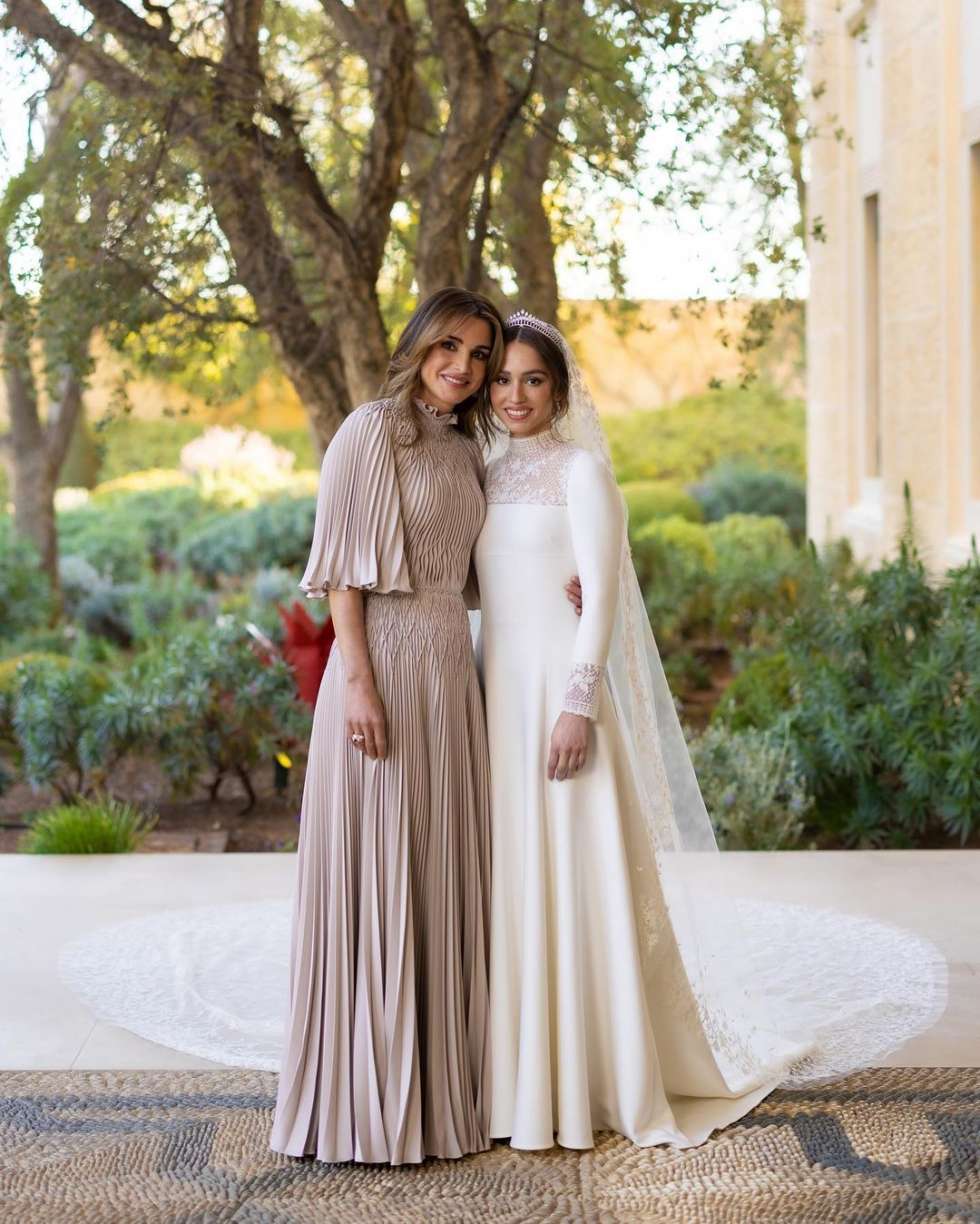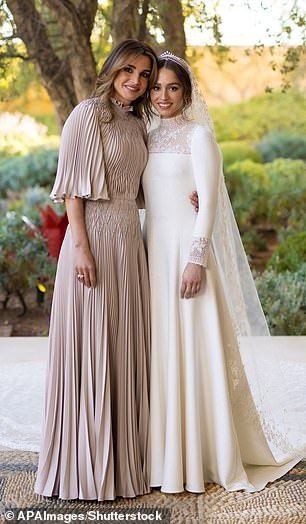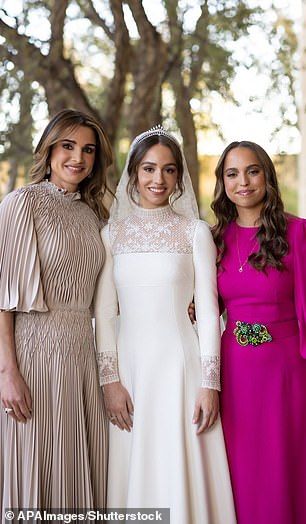When we think about members of royal families around the globe, there is often a deep sense of respect and, too, a lot of interest in their public roles and personal lives. Princess Iman bint Abdullah, a truly esteemed member of the Jordanian Royal Family, has, you know, captured the hearts of many with her poised public appearances and her clear dedication to various causes. She represents a new generation of royal figures who balance tradition with a modern approach to public service.
Born into a family with a long and storied heritage, Princess Iman carries a significant legacy, one that is, in a way, both historical and forward-looking. Her position naturally draws attention, and people are often curious about the life of someone who holds such a distinguished title. It's almost as if there's a collective wish to understand the people behind the grand titles and formal occasions, and that is quite natural.
This discussion will offer a closer look at Princess Iman bint Abdullah, exploring aspects of her life and public contributions. We will, of course, consider the meaning of her royal standing and how she contributes to her nation. We will also touch upon some general ideas about royal titles and traditions, drawing a little from historical ways of thinking about such things, like how people once addressed noble women or how a prince or princess might move into a king or queen's role.
Table of Contents
- Biography
- Personal Details and Biodata
- What Does a Princess Do?
- How Do We Address Royalty?
- What is the Significance of a Royal Title?
- A Look at Royal Traditions
- Why Do Different Nations Have Varied Royal Structures?
- Her Public Appearances and Impact
Biography
Princess Iman bint Abdullah, the second child and first daughter of King Abdullah II and Queen Rania of Jordan, was born in Amman. Her birth brought much joy to the royal household, marking another important moment in the family's story. She grew up with her siblings, Prince Hussein, Prince Hashem, and Princess Salma, in a family that, to be honest, places a strong emphasis on education and public service. Her early years were spent in Jordan, where she received her initial schooling, laying the groundwork for her future responsibilities.
Her educational pursuits took her beyond the borders of her home country, as is often the case for young people from prominent families seeking diverse academic experiences. She attended Georgetown University in Washington, D.C., a place known for its strong programs, particularly in international affairs. This period of study abroad, you know, provided her with a broader outlook and a deeper understanding of global issues. It also prepared her for the public life she would increasingly step into as she grew older, offering her a chance to develop her own ideas and perspectives.
Upon completing her studies, Princess Iman has, in a way, taken on a more visible position within the Jordanian Royal Family. Her presence at national events and her involvement in various initiatives show a clear dedication to her country and its people. She represents a fresh face for the monarchy, someone who, essentially, embodies both the deep-rooted customs of her heritage and the forward-thinking attitudes of her generation. Her life, thus far, really illustrates a path of preparation for a significant public role, blending personal growth with the duties of her station.
Personal Details and Biodata
For those interested in the foundational facts about Princess Iman bint Abdullah, here is a simple collection of some personal details. These points offer a quick view of her background and some key information about her life, giving you, basically, a clear picture of her identity within the royal family.
| Full Name | Princess Iman bint Abdullah II |
| Date of Birth | September 27, 1996 |
| Place of Birth | Amman, Jordan |
| Parents | King Abdullah II and Queen Rania Al-Abdullah |
| Siblings | Crown Prince Hussein, Prince Hashem, Princess Salma |
| Education | Georgetown University |
| Nationality | Jordanian |
What Does a Princess Do?
The role of a princess in the modern world can, in some respects, be quite varied, often depending on the specific traditions of her nation and her place in the line of succession. Historically, the word "prince" or "princess" has very deep roots. We know, for instance, that these words came into English from Old French, and before that, they really trace back to the Latin word "princeps." That Latin word, you know, meant something like "first citizen" or "leader," suggesting a person of great importance or someone who holds a primary position. So, a princess, even today, carries with her this long-standing idea of being a significant figure, often one who is an heir or close to the throne.
A princess typically represents her country, acting as a kind of ambassador for its culture and values. This might involve attending official ceremonies, meeting with foreign dignitaries, or supporting various social initiatives. For Princess Iman bint Abdullah, her duties often include participating in events that promote education, health, or youth empowerment within Jordan. She lends her presence and voice to causes that are, quite honestly, important for the welfare of her people. It's a role that demands both grace and a genuine commitment to public service, requiring her to be a visible and active participant in national life.
Beyond the formal duties, a princess also, in a way, serves as a source of inspiration and a symbol of national identity. People look to royal figures, and a princess can embody the hopes and aspirations of a society. Her actions and choices can influence public opinion and, really, encourage positive change. So, while the duties might not always be about ruling, they are definitely about leading by example and contributing to the social fabric, making her a person of considerable influence, as a matter of fact, even without direct political power.
How Do We Address Royalty?
When it comes to speaking with or about members of royalty, there are, of course, traditional forms of address that have been used for centuries. These forms reflect a deep history of respect and social order. For example, you might have heard the term "milady" used in older stories or plays. This word, which, as a matter of fact, comes directly from the phrase "my lady," was a common way to address a noble woman in English-speaking societies. It was the female equivalent of "milord," and it showed a clear acknowledgment of the person's elevated status. It's interesting to see how language evolves, yet still holds these echoes of the past.
Today, the way we address a princess like Princess Iman bint Abdullah is usually more straightforward, though still respectful. Typically, she would be referred to as "Her Royal Highness Princess Iman" in formal settings. This particular style of address is very common for royal family members who hold the title of prince or princess. It is a way of showing honor and recognizing their position without using overly complicated or archaic phrases. It's a balance, basically, between tradition and modern usage, ensuring clarity and respect in every interaction.
Understanding these forms of address is, in short, a sign of good manners and an awareness of cultural customs. While "milady" might not be in common use for contemporary royalty, knowing its origin helps us appreciate the historical context of how people have shown deference to those of noble birth. It really highlights how language adapts over time, yet still, you know, carries the weight of history in its very structure. So, when we talk about Princess Iman, using her proper title is a simple yet important gesture of respect for her and her family's standing.
What is the Significance of a Royal Title?
A royal title, such as "Princess Iman bint Abdullah," carries with it a great deal of meaning and responsibility, far beyond just being a name. It signifies a person's direct connection to a ruling family and, in many cases, a line of succession that has stretched back for generations. This connection means that the individual is seen as a symbol of their nation's heritage and its future. The title itself, as a matter of fact, helps to define a public identity, setting the person apart and placing them in a position of particular visibility.
One aspect of significance is how these titles are treated in written communication. For instance, when we write about "Princess Iman," the word "Princess" is capitalized because it is part of her specific, proper name. This is different from how we might use a general term like "a princess" when talking about any princess in the world. This practice of capitalizing proper nouns, which refer to a specific person, place, or thing, is, you know, a standard rule in writing. It helps to show that we are talking about a unique individual, rather than a general concept. This small detail, actually, underscores the distinct identity that a royal title provides.
Moreover, a royal title often comes with specific duties and expectations, as we touched on earlier. It's not merely a decorative label; it implies a role in public life, representing the monarchy and engaging with the public. The person holding the title, therefore, is expected to uphold certain standards and contribute to the welfare of their country. So, the title "Princess" for Princess Iman bint Abdullah, is really a designation that reflects both her lineage and her active participation in the life of her nation, giving her a particular kind of influence and a public purpose.
A Look at Royal Traditions
Royal families around the world are, in a way, guardians of long-standing traditions, and these customs often define their public image and internal workings. From formal ceremonies to daily protocols, tradition plays a very significant part in royal life. These practices connect the present generation to their ancestors, ensuring a sense of continuity and historical depth. For instance, the very idea of a coronation, a grand ceremony where a monarch is formally crowned, is a tradition that has been observed for centuries in many monarchies. I remember hearing, you know, how my father helped organize the coronation in 1953, and that kind of event really shows the enduring nature of these historical moments.
Such events, while perhaps less frequent in some modern monarchies, still carry immense symbolic weight. They are public affirmations of the royal family's role and their connection to the people. Beyond coronations, there are also traditions surrounding royal weddings, jubilees, and even the way royal children are raised. These customs are not just about pomp and circumstance; they are, in some respects, about reinforcing the identity of the monarchy and its place within the national story. Princess Iman bint Abdullah, as a member of a royal family, participates in and upholds many of these traditions, contributing to the ongoing narrative of her family's heritage.
The continuity of these traditions also provides a sense of stability for a nation. In a world that often seems to be changing very quickly, the steadfastness of royal customs can be a comforting presence. They offer a link to the past while, you know, adapting to the present. So, whether it is the formal way a royal is addressed or the ceremonies they attend, these traditions are an important part of what it means to be a royal family member, shaping their public persona and connecting them to a long line of historical figures. It's a way of, essentially, keeping history alive in the present day.
Why Do Different Nations Have Varied Royal Structures?
It's interesting to consider why different countries that have monarchies do things in their own distinct ways. For example, someone once asked me why Great Britain has both a King and a Queen, which is a really good question that points to the many different forms monarchies can take. Some nations have a ruling monarch, like a king or queen, who holds significant political power, while others, like Great Britain, have a monarch who primarily serves as a head of state with ceremonial duties. This variety, you know, comes from different historical paths, constitutional developments, and cultural choices made over centuries.
The role of a princess, like Princess Iman bint Abdullah, can also vary significantly depending on her nation's specific royal structure. In some monarchies, her duties might be more focused on supporting charitable organizations and cultural events, while in others, she might have a more direct role in national governance or diplomacy. These differences are a reflection of each country's unique relationship with its monarchy. Some nations have moved towards constitutional monarchies, where the monarch's power is limited by a constitution, while others maintain more traditional systems.
Understanding these distinctions helps us appreciate the specific context of each royal family. The Jordanian monarchy, for instance, has its own particular history and set of responsibilities that shape the roles of its members, including Princess Iman. So, while the title "princess" might seem universal, its practical meaning and the expectations that come with it are, in fact, quite particular to each country. It really shows how diverse the world's royal families are, each with their own special way of contributing to their nation's identity and future, offering a truly unique blend of tradition and modern governance.
Her Public Appearances and Impact
Princess Iman bint Abdullah has, over the years, become an increasingly visible figure in public life, representing the Jordanian Royal Family at various events both at home and abroad. Her appearances are always marked by a quiet grace and a clear sense of purpose. She often accompanies her parents, King Abdullah II and Queen Rania, to official functions, learning from their example and gradually taking on more responsibilities. These public moments, you know, allow the people of Jordan and the wider world to see her dedication to her duties.
Her impact stems not just from her presence, but also from the causes she chooses to support. While specific details of her personal initiatives are often kept private, her general involvement aligns with the broader goals of the Jordanian monarchy, which often prioritize education, youth development, and community welfare. By lending her name and time to these efforts, she helps to draw attention to important social issues and, in a way, encourages broader participation in making positive changes within the country. It's a quiet but significant form of leadership.
Princess Iman's public image is one of a thoughtful and dedicated young woman who is preparing for a lifetime of service. She embodies a blend of traditional royal values and a contemporary approach to engaging with the world. Her presence on the global stage, whether at a state dinner or a local community event, reflects well on her nation and, basically, showcases the future of the Jordanian monarchy. She is, quite simply, a vital part of her family's ongoing commitment to their people, offering a modern face to an ancient institution.
This discussion has offered a closer look at Princess Iman bint Abdullah, exploring aspects of her life, her role as a princess, and the significance of royal titles and traditions. We considered her background, personal details, and how her public presence contributes to her nation. The article also touched upon the historical origins of royal terms and the varied structures of monarchies worldwide, providing a broader context for understanding her position.



Author Details:
- Name : Zoe Hessel
- Username : mmuller
- Email : efisher@kozey.biz
- Birthdate : 1995-04-24
- Address : 988 Kihn Rapids East Marisa, UT 87686-9796
- Phone : +1 (947) 969-7336
- Company : Wiza, Bednar and Koepp
- Job : Costume Attendant
- Bio : Dignissimos saepe aut quaerat est exercitationem ea ut qui. Et enim sed libero possimus incidunt. Totam fugiat quos enim sed exercitationem voluptatum odit nobis.
Social Media
Twitter:
- url : https://twitter.com/jaydon_west
- username : jaydon_west
- bio : Illum quas cupiditate eum facere voluptatem aut. Et modi quia ab ipsum ipsam aliquam ea commodi.
- followers : 2349
- following : 1333
Tiktok:
- url : https://tiktok.com/@jaydon.west
- username : jaydon.west
- bio : Occaecati eius est numquam. Ea veniam quisquam ut saepe illo.
- followers : 131
- following : 129
